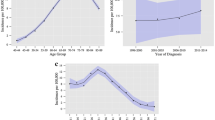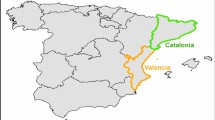Abstract
The incidence and mortality of motor neuron disease (MND) increase with age and appear to have increased with time. The examination of period and cohort effects using age-period-cohort (APC) models can help characterize temporal trends. Our objective was to describe mortality from MND in France (1968–2007), and to examine the role of age, period of death, and birth-cohort on changes in mortality. The number of people who died from MND and population statistics (1968–2007) were extracted from French national records. Annual standardized (age/sex) mortality ratios (SMRs) were computed. Using Poisson regression, APC models examined the relationship between mortality rates and age, period of death, and birth-cohort in subjects aged 40–89 years. Deviance/degrees-of-freedom ratios evaluated model fit; ratios close to one indicated adequate fit. Between 1968 and 2007, 38,863 individuals died from MND (mortality rate = 1.74/100,000); 37,624 were aged 40–89 years. SMRs increased from 54 (95% CI = 49–59) in 1968 to 126 (120–132) in 2007. Male-to-female ratios declined from 1.80 in 1968 to 1.45 in 2007. Changing mortality rates were best explained by cohort effects (deviance/degrees-of-freedom = 1.09). The relative risk of dying from MND increased markedly for persons born between 1880 and 1920, and more slowly after 1920. In conclusion, mortality rates for MND increased between 1968 and 2007, and more rapidly in women than men. This increase was better explained by the birth-cohort of individuals than by period effects. Changing environmental exposures may be a possible explanation and these findings warrant the continued search for environmental risk factors for MND.




Similar content being viewed by others
Abbreviations
- AIC:
-
Akaike’s information criterion
- ALS:
-
Amyotrophic lateral sclerosis
- APC model:
-
Age-period-cohort model
- ICD:
-
International classification of diseases
- MND:
-
Motor neuron disease
- SMR:
-
Standardized mortality ratio
References
Annegers JF, Appel S, Lee JR, Perkins P. Incidence and prevalence of amyotrophic lateral sclerosis in Harris County, Texas, 1985–1988. Arch Neurol. 1991;48:589–93.
Beghi E, Millul A, Micheli A, Vitelli E, Logroscino G. Incidence of ALS in Lombardy, Italy. Neurology. 2007;68:141–5.
Marin B, Gil J, Preux PM, Funalot B, Couratier P. Incidence of amyotrophic lateral sclerosis in the Limousin region of France, 1997–2007. Amyotroph Later Scler. 2009;10:216–20.
Alonso A, Logroscino G, Jick SS, Hernan MA. Incidence and lifetime risk of motor neuron disease in the United Kingdom: a population-based study. Eur J Neurol. 2009;16:745–51.
Chio A, Mora G, Calvo A, Mazzini L, Bottacchi E, Mutani R. Epidemiology of ALS in Italy: a 10-year prospective population-based study. Neurology. 2009;72:725–31.
Fang F, Valdimarsdottir U, Bellocco R, Ronnevi LO, Sparen P, Fall K, et al. Amyotrophic lateral sclerosis in Sweden, 1991–2005. Arch Neurol. 2009;66:515–9.
Murphy M, Quinn S, Young J, Parkin P, Taylor B. Increasing incidence of ALS in Canterbury, New Zealand: a 22-year study. Neurology. 2008;71:1889–95.
Sorenson EJ, Stalker AP, Kurland LT, Windebank AJ. Amyotrophic lateral sclerosis in Olmsted County, Minnesota, 1925 to 1998. Neurology. 2002;59:280–2.
Mandrioli J, Faglioni P, Merelli E, Sola P. The epidemiology of ALS in Modena, Italy. Neurology. 2003;60:683–9.
Seljeseth YM, Vollset SE, Tysnes OB. Increasing mortality from amyotrophic lateral sclerosis in Norway? Neurology. 2000;55:1262–6.
Maasilta P, Jokelainen M, Loytonen M, Sabel CE, Gatrell AC. Mortality from amyotrophic lateral sclerosis in Finland, 1986–1995. Acta Neurol Scand. 2001;104:232–5.
Noonan CW, White MC, Thurman D, Wong LY. Temporal and geographic variation in United States motor neuron disease mortality, 1969–1998. Neurology. 2005;64:1215–21.
Nelson LM, McGuire V, Longstreth WT Jr, Matkin C. Population-based case-control study of amyotrophic lateral sclerosis in western Washington State. I. Cigarette smoking and alcohol consumption. Am J Epidemiol. 2000;151:156–63.
Gallo V, Bueno-De-Mesquita HB, Vermeulen R, Andersen PM, Kyrozis A, Linseisen J, et al. Smoking and risk for amyotrophic lateral sclerosis: analysis of the EPIC cohort. Ann Neurol. 2009;65:378–85.
Scarmeas N, Shih T, Stern Y, Ottman R, Rowland LP. Premorbid weight, body mass, and varsity athletics in ALS. Neurology. 2002;59:773–5.
Sutedja NA, Veldink JH, Fischer K, Kromhout H, Heederik D, Huisman MH, et al. Exposure to chemicals and metals and risk of amyotrophic lateral sclerosis: a systematic review. Amyotroph Later Scler. 2009;10:302–9.
Clayton D, Schifflers E. Models for temporal variation in cancer rates. I: age-period and age-cohort models. Stat Med. 1987;6:449–67.
Clayton D, Schifflers E. Models for temporal variation in cancer rates. II: age-period-cohort models. Stat Med. 1987;6:469–81.
Durrleman S, Alperovitch A. Increasing trend of ALS in France and elsewhere: are the changes real? Neurology. 1989;39:768–73.
Hill C, Doyon F. Age in completed years versus age reached during the year. Rev Epidemiol Sante Publique. 2005;53:205–8.
Holford TR. The estimation of age, period and cohort effects for vital rates. Biometrics. 1983;39:311–24.
Carstensen B. Age-period-cohort models for the Lexis diagram. Stat Med. 2007;26:3018–45.
Dean G, Elian M. Motor neuron disease and multiple sclerosis mortality in Australia, New Zealand and South Africa compared with England and Wales. J Neurol Neurosurg Psychiatr. 1993;56:633–7.
Chio A, Magnani C, Schiffer D. Amyotrophic lateral sclerosis mortality in Italy, 1958 to 1987: a cross-sectional and cohort study. Neurology. 1993;43:927–30.
O’Toole O, Traynor BJ, Brennan P, Sheehan C, Frost E, Corr B, et al. Epidemiology and clinical features of amyotrophic lateral sclerosis in Ireland between 1995 and 2004. J Neurol Neurosurg Psychiatr. 2008;79:30–2.
Ragonese P, Filippini G, Salemi G, Beghi E, Citterio A, D’Alessandro R, et al. Accuracy of death certificates for amyotrophic lateral sclerosis varies significantly from north to south of Italy: implications for mortality studies. Neuroepidemiology. 2004;23:73–7.
Riggs JE. Longitudinal Gompertzian analysis of amyotrophic lateral sclerosis mortality in the US, 1977–1986: evidence for an inherently susceptible population subset. Mech Ageing Dev. 1990;55:207–20.
Neilson S, Robinson I, Alperovitch A. Rising amyotrophic lateral sclerosis mortality in France 1968–1990: increased life expectancy and inter-disease competition as an explanation. J Neurol. 1994;241:448–55.
Chio A, Magnani C, Oddenino E, Tolardo G, Schiffer D. Accuracy of death certificate diagnosis of amyotrophic lateral sclerosis. J Epidemiol Community Health. 1992;46:517–8.
Kondo K, Tsubaki T. Changing mortality patterns of motor neuron disease in Japan. J Neurol Sci. 1977;32:411–24.
Hoffman PM, Brody JA. The reliability of death certificate reporting for amyotrophic lateral sclerosis. J Chronic Dis. 1971;24:5–8.
Juergens SM, Kurland LT, Okazaki H, Mulder DW. ALS in Rochester, Minnesota, 1925–1977. Neurology. 1980;30:463–70.
Kurtzke JF, Beebe GW. Epidemiology of amyotrophic lateral sclerosis: 1. A case-control comparison based on ALS deaths. Neurology. 1980;30:453–62.
Marin B, Couratier P, Preux PM, Logroscino G. Can mortality data be used to estimate amyotrophic lateral sclerosis incidence? Neuroepidemiology. 2011;36:29–38.
Preux PM, Druet-Cabanac M, Couratier P, Debrock C, Truong T, Marcharia W, et al. Estimation of the amyotrophic lateral sclerosis incidence by capture-recapture method in the Limousin region of France. J Clin Epidemiol. 2000;53:1025–9.
Logroscino G, Traynor BJ, Hardiman O, Chio A, Mitchell D, Swingler RJ, et al. Incidence of amyotrophic lateral sclerosis in Europe. J Neurol Neurosurg Psychiatr. 2010;81:385–90.
Author information
Authors and Affiliations
Corresponding author
Electronic supplementary material
Below is the link to the electronic supplementary material.
Appendix: age-period-cohort models
Appendix: age-period-cohort models
The mortality rates λ ijk for age i, period j, and cohort k (k = j − i) are λ ijk = m ijk /T ijk , where m ijk is the expected number of deaths and T ijk the number of person-years for the ijk combination. The observed number of deaths, n ijk , is considered to arise from a Poisson distribution with mean m ijk . Age-period-cohort models assume that the three time factors, age, period, and cohort have an additive effect on the logarithm of the rates and can be generally written as log λ ijk = μ + α i + β j + γ k , where age effects are represented by α i , period effects by β j , and cohort effects by γ k . Poisson regression is used to model mortality rates using person-years as an offset.
Clayton and Schifflers [17, 18] have proposed a sequential procedure (supplementary figure 1). Models of increasing complexity, depending on which terms are included in the regression model, are sequentially fitted to the data:
-
Model 1: Age
-
Model 2: Age-Drift (the drift parameter fits a simple linear trend in mortality with time)
-
Model 3: Age-Period
-
Model 4: Age-Cohort
-
Model 5: Age-Period-Cohort
Model 1 assesses whether mortality changes with age. Model 2 evaluates whether there are additional linear trends that cannot ascribed to period or cohort effects. If this model does not fit adequately the data, then more complex models can be evaluated. Model 3 evaluates the presence of period effects and model 4 tests for cohort effects. If none of these models fits the data adequately, model 5, which includes age, period, and cohort effects, is fitted.
The goodness-of-fit of the models is assessed through ratios of deviance to the degrees of freedom; ratios that are closer to one indicate a better fit. A lower value of the Akaike’s information criterion (AIC) also indicates a better fit. Models can be compared using the difference between their deviances; under the null hypothesis, this difference follows a chi-square distribution whose degrees of freedom are computed as the difference between degrees of freedom from the two models that are compared.
Rights and permissions
About this article
Cite this article
Gordon, P.H., Artaud, F., Aouba, A. et al. Changing mortality for motor neuron disease in France (1968–2007): an age-period-cohort analysis. Eur J Epidemiol 26, 729–737 (2011). https://doi.org/10.1007/s10654-011-9595-0
Received:
Accepted:
Published:
Issue Date:
DOI: https://doi.org/10.1007/s10654-011-9595-0




